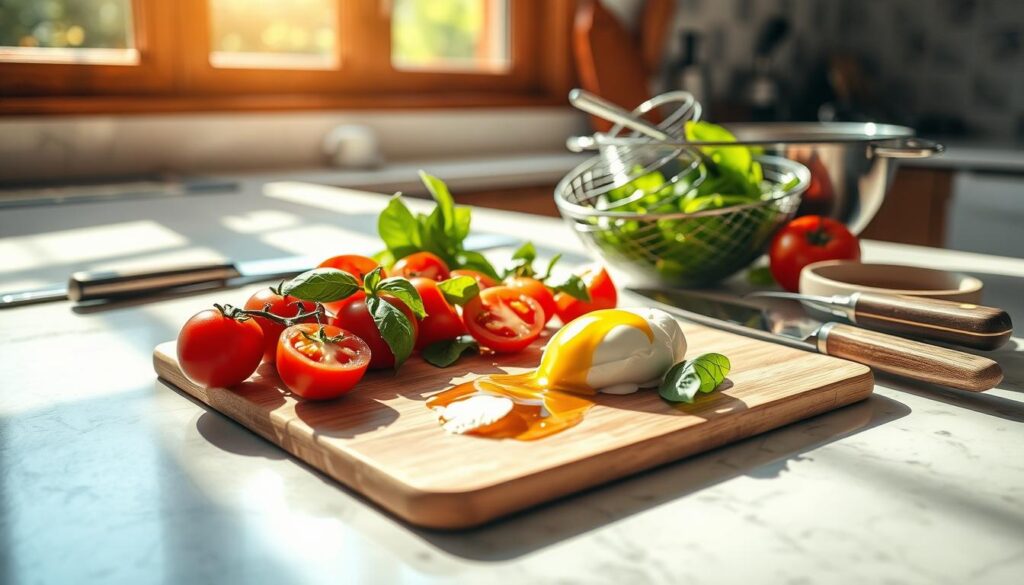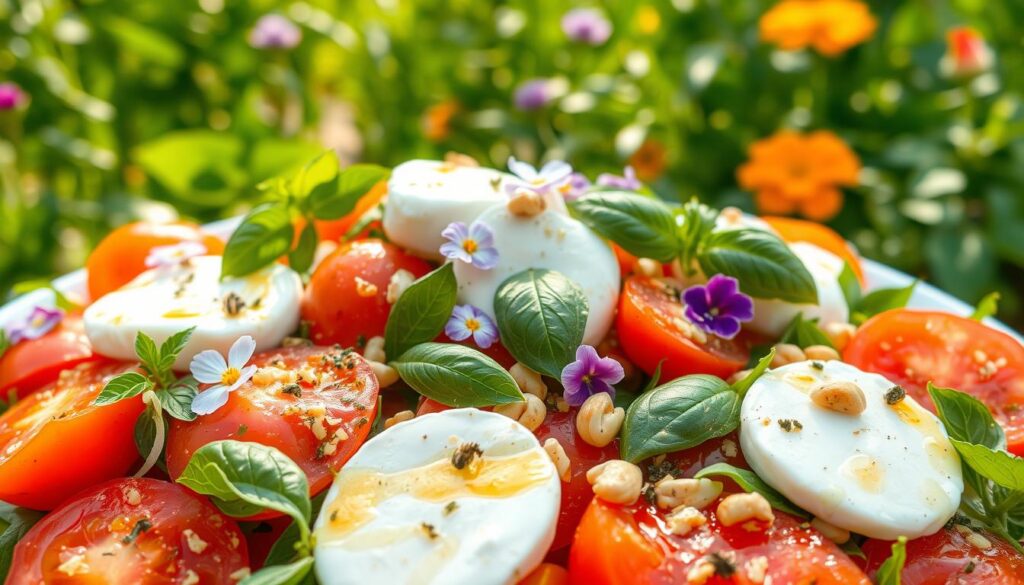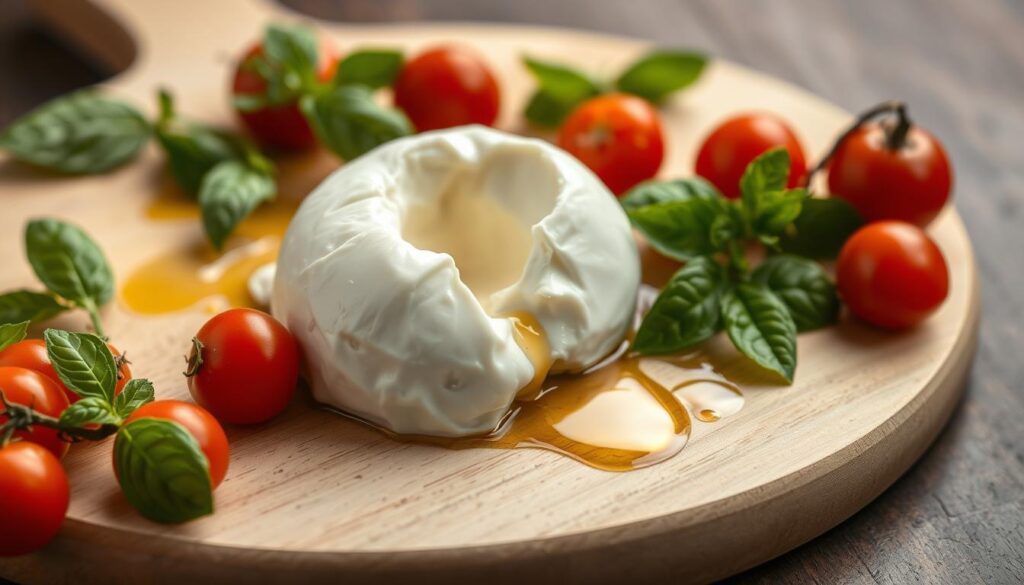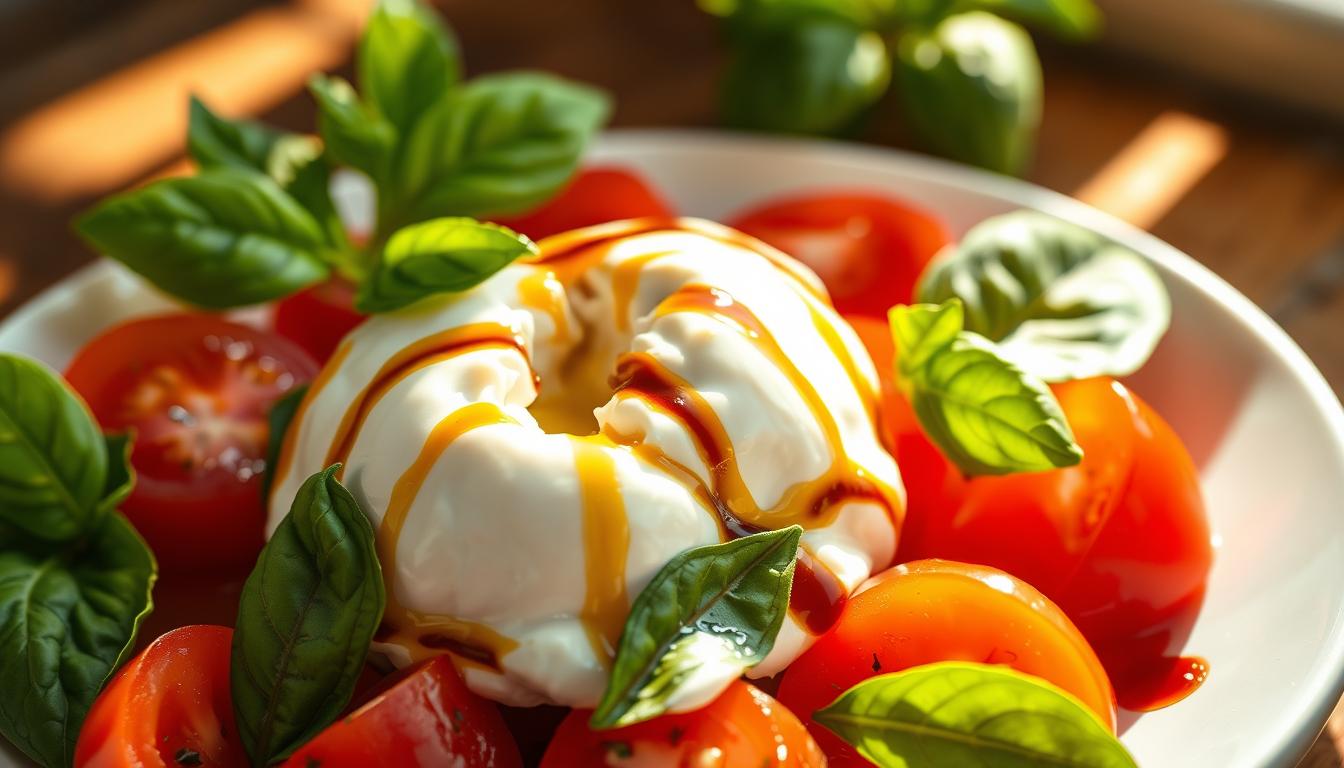Indulge in the rich flavors of Italy with our guide to creating the perfect burrata caprese salad. This classic dish, elevated by the creamy texture of burrata cheese, is a staple of Italian cuisine and a crowd-pleaser at any gathering.
The simplicity of this salad belies its rich flavor profile, making it a beloved choice for many. In this article, we’ll explore the history and ingredients that make this dish so special.
Key Takeaways
- Learn the history behind the classic Italian salad
- Discover the key ingredients that make it special
- Master the preparation methods to elevate your dish
- Explore variations to suit your taste preferences
- Understand the significance of burrata cheese in this salad
The Allure of Fresh Italian Cuisine
The Burrata Caprese Salad embodies the Italian culinary philosophy of letting fresh ingredients shine. Italian cuisine is renowned for its emphasis on freshness and simplicity, principles that are beautifully represented in this salad. By combining the richness of burrata cheese with the vibrant flavors of tomatoes and basil, the Burrata Caprese Salad offers a quintessential Italian dining experience.
A Modern Twist on a Classic Dish
The traditional Caprese salad, made with fresh mozzarella, tomatoes, and basil, has been a staple of Italian cuisine for decades. The Burrata Caprese Salad puts a modern twist on this classic by substituting burrata cheese for the traditional mozzarella. This substitution elevates the dish, adding a creamy texture that complements the fresh tomatoes and basil.
As Giorgio Locatelli, a renowned Italian chef, once said,
“The quality of the ingredients is fundamental. The simplicity of Italian cuisine is what makes it so beautiful.”
The Burrata Caprese Salad is a testament to this philosophy, showcasing the beauty of simple, high-quality ingredients.
What Makes Burrata Different from Regular Mozzarella
Burrata cheese is distinct from regular mozzarella due to its unique composition. While mozzarella is a solid cheese, burrata is a ball of mozzarella filled with shredded stracciatella and cream, giving it a rich, creamy center. This difference in texture and flavor makes burrata a more decadent and indulgent choice for the Caprese salad, turning it into a truly special Italian appetizer.
The use of burrata instead of mozzarella adds a layer of complexity to the salad, making it more than just a simple arrangement of ingredients. It’s an experience of textures and flavors that highlight the best of Italian cuisine.
The Rich History of Caprese Salad
With roots tracing back to the island of Capri, the Caprese salad is more than just a simple salad. It’s a representation of Italian cuisine’s emphasis on fresh, high-quality ingredients.
Origins in Capri, Italy
The Caprese salad originated in Capri, where it was created as a tribute to the island’s colors: red tomatoes, white mozzarella, and green basil. This simple yet flavorful salad quickly gained popularity.
Evolution to Include Burrata Cheese
Over time, the traditional Caprese salad evolved with the introduction of burrata cheese, adding a creamy texture to the dish. This variation, known as Burrata Caprese, has become a favorite among those who enjoy a richer take on the classic.
Cultural Significance in Italian Cuisine
The Caprese salad, including its Burrata variation, holds significant cultural value in Italian cuisine. It represents the Italian philosophy of enjoying life’s simple pleasures, like a well-crafted meal made from fresh, local ingredients. As a traditional Italian dish, it continues to be celebrated worldwide.
By understanding its history and evolution, we can appreciate the Burrata Caprese salad not just as a meal, but as a connection to Italian heritage and the joy of simple, delicious food.
Essential Ingredients for the Perfect Burrata Caprese Salad
Creating a sublime Burrata Caprese Salad begins with selecting the finest ingredients. The quality of the burrata cheese, tomatoes, basil, olive oil, and balsamic glaze directly impacts the overall flavor and texture of the dish.
Selecting Quality Burrata Cheese
When it comes to burrata cheese, freshness is paramount. Look for burrata that is well-sealed and has a creamy center.
What to Look For When Purchasing
Opt for burrata from reputable sources or local dairy shops. The packaging should be intact, and the cheese should have a pleasant, milky aroma.
Freshness Indicators
Check the expiration date and ensure the cheese feels cool to the touch. Fresh burrata should have a smooth, white exterior.
Choosing the Right Tomatoes
The type and ripeness of tomatoes can make or break the salad. Heirloom tomatoes are a popular choice due to their varied colors and rich flavors.
Heirloom vs. Regular Varieties
Heirloom tomatoes offer a more complex taste profile, while regular tomatoes provide consistency. Choose based on personal preference or what’s in season.
Ripeness Considerations
Tomatoes should be ripe but still firm. Avoid overly soft or green tomatoes, as they can negatively impact the salad’s overall taste.
Fresh Basil Selection
Fresh basil adds a bright, herbaceous note to the salad. Select leaves that are vibrant green and free of blemishes.
Olive Oil Considerations
A high-quality olive oil can enhance the flavors of the salad. Opt for extra virgin olive oil with a fruity or peppery note to complement the other ingredients.
Balsamic Glaze Options
Balsamic glaze adds a tangy, sweet element. You can either purchase pre-made glaze or make your own by reducing balsamic vinegar on the stovetop.
Tools and Equipment You’ll Need
To create a stunning gourmet summer salad, you’ll need the right tools and equipment. Preparing a delicious Burrata Caprese Salad requires attention to detail, and having the proper tools can make a significant difference.
Essential Kitchen Tools
You’ll need a few essential kitchen tools to prepare your Burrata Caprese Salad. These include a sharp chef’s knife for cutting the tomatoes and basil, a cutting board for preparing the ingredients, and a large serving platter for presenting the salad.
Optional Specialty Items
While not necessary, some specialty items can enhance your salad-making experience. Consider using a basil trimmer to keep your basil fresh, or a cheese knife specifically designed for cutting burrata cheese.
Serving Platters and Presentation Pieces
The presentation of your Burrata Caprese Salad is just as important as its taste. Choose a beautiful serving platter that complements the colors of your salad. You can also use garnishes like edible flowers or fresh herbs to add a touch of elegance.

Step-by-Step Preparation of Burrata Caprese Salad
To craft a beautiful and tasty Burrata Caprese Salad, follow these step-by-step instructions. This guide will walk you through preparing the tomatoes, handling the burrata cheese, arranging the salad, and adding the finishing touches.
Preparing the Tomatoes
Selecting the right tomatoes is crucial for a great Caprese salad. For an heirloom tomato salad, choose ripe, colorful tomatoes.
Slicing Techniques
Slice the tomatoes into uniform thickness, about 1/4 inch. This ensures even distribution of flavors.
Removing Seeds (Optional)
If your tomatoes are particularly seedy, you may want to remove the seeds to avoid a watery salad. Use a spoon to gently scoop out the seeds.
Handling the Burrata
Burrata cheese is the star of this salad. Handle it carefully to maintain its creamy center.
Proper Temperature
Keep the burrata at room temperature before serving. This enhances its creamy texture.
Cutting and Serving Methods
Cut the burrata just before serving. Use a sharp knife to avoid tearing the cheese. Serve immediately to enjoy its oozy center.
Arranging the Salad
On a large platter, arrange the tomato slices in a circular pattern, leaving space in the center for the burrata.
Adding the Finishing Touches
The final touches can elevate your salad from good to great.
Drizzling Techniques
Drizzle a high-quality olive oil over the salad, followed by a balsamic glaze for a rich, tangy flavor characteristic of a balsamic glaze salad.
Final Seasoning
Season with salt and freshly ground black pepper. Add fresh basil leaves for a pop of color and fragrance.
| Ingredient | Quantity | Tips |
|---|---|---|
| Tomatoes | 3-4 | Choose ripe, colorful tomatoes |
| Burrata Cheese | 1 ball | Keep at room temperature |
| Fresh Basil | A handful | Use fresh leaves for best flavor |
By following these steps, you’ll create a stunning Burrata Caprese Salad that’s sure to impress. Enjoy the harmony of flavors and textures in this classic Italian dish.
Mastering the Burrata Caprese Salad: Expert Tips
Expert insights can transform your Burrata Caprese Salad from good to exceptional. To achieve this, several key factors come into play.
Temperature Considerations
Serving your Burrata Caprese Salad at the right temperature is crucial. The burrata cheese should be at room temperature to ensure it’s creamy and soft, while the tomatoes should be fresh and cool. This contrast enhances the overall flavor and texture.
Timing Your Preparation
Timing is everything when preparing a Burrata Caprese Salad. It’s best to assemble the salad just before serving to prevent the bread from getting soggy and the flavors from melding together too much. Prepare the components ahead of time, but assemble just before serving.
Common Mistakes to Avoid
One common mistake is using low-quality ingredients. Fresh, high-quality ingredients make a significant difference in the taste and presentation of the salad. Another mistake is overdressing the salad; a light drizzle of olive oil and balsamic glaze is sufficient.
Professional Chef Recommendations
Professional chefs often recommend using a variety of heirloom tomatoes to add color and depth to the salad. Additionally, they suggest being gentle when handling the burrata to prevent it from breaking apart. Use a sharp knife when cutting the tomatoes and burrata to ensure clean cuts.
By following these expert tips, you can elevate your Burrata Caprese Salad and create a truly memorable Italian appetizer experience.
Creative Variations of Burrata Caprese Salad
The classic Burrata Caprese Salad is a canvas waiting for your creative brushstrokes. While it stands beautifully on its own, experimenting with different ingredients can take it to new culinary heights. This versatility is part of what makes Italian cuisine so beloved worldwide.
Heirloom Tomato Version
One of the simplest ways to add a twist to the traditional Burrata Caprese is by using heirloom tomatoes. These tomatoes come in a variety of colors and patterns, adding a visual appeal that’s as pleasing as the taste. Their slightly different flavors, ranging from sweeter to tangier, complement the creamy burrata cheese perfectly.
Peach and Burrata Caprese
Incorporating peaches into your Burrata Caprese Salad might sound unusual, but it’s a surprisingly delightful combination. The sweetness of ripe peaches pairs exquisitely with the creaminess of burrata, creating a fresh and summery flavor profile. Drizzle with a balsamic glaze for a touch of acidity to balance the sweetness.
Watermelon Burrata Twist
For a refreshing summer salad, consider adding watermelon to your Burrata Caprese. The refreshing juiciness of watermelon complements the richness of the burrata, making for a light and satisfying dish. This variation is perfect for hot summer days when you need something cooling and easy to digest.
Avocado Addition
Adding sliced or diced avocado to your Burrata Caprese introduces a creamy texture that complements the burrata cheese. The healthy fats in avocado also make the dish more filling, turning it into a more substantial meal or side dish.
Grilled Elements for Depth of Flavor
Grilling certain elements of your Burrata Caprese Salad, like the bread or even the tomatoes, can add a depth of flavor that’s incredibly appealing. The smokiness from grilling enhances the overall taste experience, making it a great option for those looking to add a bit of complexity to this classic salad.
As you can see, the Burrata Caprese Salad is a versatile dish that can be modified and enhanced in numerous ways. Whether you’re looking to add a pop of color, a burst of flavor, or a new texture, there’s a variation out there for you. As Giada De Laurentiis once said, “The key to a great salad is in the quality of its ingredients and the love with which it’s prepared.” So, don’t be afraid to experiment and make the Burrata Caprese Salad your own.
Pairing Suggestions for Your Burrata Caprese Salad
Elevate your dining experience by pairing your Burrata Caprese Salad with the perfect accompaniments. A well-chosen wine or complementary main dish can enhance the flavors of this gourmet summer salad.
Wine Pairings
For a classic Italian experience, consider pairing your tomato and mozzarella salad with a crisp white wine.
White Wine Options
Pinot Grigio or Sauvignon Blanc are excellent choices, as their acidity complements the creaminess of the burrata.
Red Wine Possibilities
If you prefer red wine, a light-bodied Pinot Noir can work well, especially during cooler months.
Complementary Main Dishes
Pair your Burrata Caprese Salad with grilled chicken or seafood for a well-rounded meal.
| Main Dish | Wine Pairing | Additional Sides |
|---|---|---|
| Grilled Chicken | Pinot Grigio | Garlic Bread |
| Seafood Risotto | Sauvignon Blanc | Roasted Vegetables |

Seasonal Adaptations for Year-Round Enjoyment
By incorporating seasonal ingredients, you can keep your Burrata Caprese Salad fresh and exciting 365 days a year. This traditional Italian dish is versatile and can be adapted to reflect the best of each season.
Summer: Peak Season Preparation
Summer is the peak season for Burrata Caprese Salad, with fresh tomatoes and basil at their best. Use heirloom tomatoes for a colorful and flavorful salad. The warm weather allows for outdoor dining, making it perfect for serving at garden parties or barbecues.
Fall and Winter Alternatives
In fall and winter, consider using roasted or grilled fruits like pears or persimmons as alternatives to tomatoes. This adds a sweet and savory twist to the traditional salad.
Spring Variations
Spring brings a variety of fresh greens and herbs. Incorporate early spring tomatoes or strawberries for a sweet take on the classic recipe.
Ingredient Substitutions When Necessary
Don’t be afraid to substitute ingredients based on seasonality. For example, use citrus segments in winter or roasted vegetables in fall to keep the salad interesting.
Storage and Make-Ahead Options
The key to enjoying your Burrata Caprese Salad at its best lies in proper storage and preparation planning. Whether you’re preparing for a dinner party or simply want to enjoy a fresh salad throughout the week, understanding how to handle leftovers and prepare components in advance is essential.
How to Store Leftover Components
To keep your Burrata Caprese Salad components fresh, store them separately. Place the burrata cheese in an airtight container, submerged in its brine, and refrigerate. Tomatoes and basil should be stored separately in the refrigerator, with tomatoes ideally at room temperature a few hours before serving to enhance flavor.
Preparing Elements in Advance
You can prepare several elements of the Burrata Caprese Salad ahead of time. Slice the tomatoes and store them in an airtight container in the refrigerator. Prepare the balsamic glaze and store it at room temperature. However, assemble the salad just before serving to maintain the freshness and texture of the burrata cheese.

Refreshing a Pre-Made Salad
If you’ve prepared the salad in advance, refresh it by drizzling a bit more olive oil and balsamic glaze over the top. You can also add a sprinkle of salt to revive the flavors.
Food Safety Considerations
When storing and reheating any components, ensure they are kept at safe temperatures. Refrigerate perishable items promptly, and consume the salad within a day of preparation for optimal safety and quality.
| Component | Storage Method | Best Consumed Within |
|---|---|---|
| Burrata Cheese | Airtight container, submerged in brine, refrigerated | 1 day |
| Tomatoes | Airtight container, refrigerated | 3 days |
| Basil | Wrapped in damp paper towel, refrigerated | 2 days |
Nutritional Benefits of Burrata Caprese Salad
While often considered indulgent, the Burrata Caprese Salad has several health benefits worth exploring. This gourmet summer salad combines fresh ingredients that not only delight the palate but also provide nutritional value.
Caloric and Macronutrient Breakdown
A typical serving of Burrata Caprese Salad contains approximately 300-400 calories, with a balance of fats, carbohydrates, and proteins. The burrata cheese is high in fat, while the tomatoes and basil add natural sugars and fiber.
| Nutrient | Amount per Serving |
|---|---|
| Calories | 350 |
| Fat | 25g |
| Carbohydrates | 15g |
| Protein | 10g |
Health Benefits of Key Ingredients
The tomatoes in the salad are rich in lycopene, an antioxidant that has been linked to several health benefits. Fresh basil adds vitamins A and K, while the olive oil used in the dressing provides healthy fats.
Dietary Considerations
While the Burrata Caprese Salad is generally suitable for most diets, it may not be appropriate for those with dairy intolerance or gluten-free requirements.
Modifications for Special Diets
To make this salad more inclusive, consider substituting the burrata with a vegan alternative or using gluten-free bread for croutons.
Conclusion: Celebrating the Simple Elegance of Italian Cuisine
The Burrata Caprese Salad is a testament to the simple elegance of Italian cuisine, where a few high-quality ingredients come together to create something truly special. This traditional Italian dish has captured the hearts of many with its creamy burrata cheese, fresh tomatoes, and basil, all harmoniously combined.
As we’ve explored throughout this article, the beauty of Burrata Caprese Salad lies in its versatility and the ease of preparation. From selecting the finest ingredients to presenting the dish, every step is a celebration of Italian culinary tradition. Whether you’re a seasoned chef or a culinary novice, this salad is sure to impress.
Embracing the simplicity and richness of Italian cuisine, the Burrata Caprese Salad is more than just a meal – it’s an experience. We encourage you to continue exploring the many delights of Italian cooking, experimenting with new ingredients and recipes, and savoring the flavors that make this cuisine so beloved.

